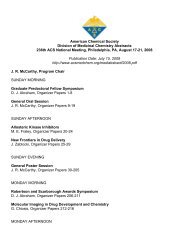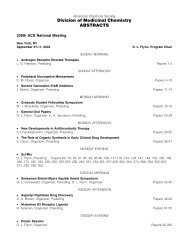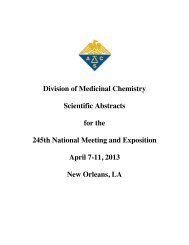Division of Medicinal Chemistry Abstracts-235th ACS National ...
Division of Medicinal Chemistry Abstracts-235th ACS National ...
Division of Medicinal Chemistry Abstracts-235th ACS National ...
- No tags were found...
You also want an ePaper? Increase the reach of your titles
YUMPU automatically turns print PDFs into web optimized ePapers that Google loves.
life <strong>of</strong> 52 min and the tumor uptake was significantly higher (1.8 ± 0.7%ID/g).We prepared<br />
radiochemically pure, Tc-99m-labeled chlorotoxin, multimerization <strong>of</strong> chlrotoxin resulted in<br />
enhanced affinity for cancer cell lines. The high uptake by tumor makes this trimeric chlorotoxin<br />
as the favorable ligand for tumor targeting in vivo.<br />
MEDI 15<br />
Multidentate small molecule inhibitors <strong>of</strong> VHR phosphatase: A new drug target for the<br />
treatment <strong>of</strong> cervical cancer<br />
Lutz Tautz 1 , Ana V. Miletic 1 , Shuangding Wu 1 , Fabio Cerigno 1 , Yutaka Arimura 1 , Torkel Vang 1 ,<br />
Jesus Vazquez 1 , Scott Williams 1 , Rachel Henkens 2 , Tikva Hayes 1 , Stefan Vasile 3 , Souad<br />
Rahmouni 2 , Maurizio Pellecchia 1 , and Tomas Mustelin 1 . (1) Infectious and Inflammatory<br />
Disease Center, Burnham Institute for Medical Research, 10901 N Torrey Pines Rd, La Jolla,<br />
CA 92037, tautz@burnham.org, (2) Liège University, Liège, Belgium, (3) High Throughput<br />
Screening Center, Burnham Institute for Medical Research, La Jolla, CA 92037<br />
VHR is a dual-specific phosphatase and a negative regulator <strong>of</strong> the Erk and Jnk mitogenactivated<br />
protein kinase pathways. Loss <strong>of</strong> VHR causes cell cycle arrest in HeLa cervix<br />
carcinoma cells, suggesting that VHR inhibition may be a useful approach to halt the growth <strong>of</strong><br />
cancer cells. Moreover, VHR was found to be upregulated in several cervix cancer cell lines as<br />
well as in squamous intraepithelial lesions and squamous cell carcinomas <strong>of</strong> the uterine cervix.<br />
Here we report the development <strong>of</strong> novel multidentate small molecule inhibitors <strong>of</strong> VHR that<br />
inhibit its enzymatic activity at nanomolar concentrations in vitro and hold the growth <strong>of</strong> cancer<br />
cells at low micromolar concentrations. High throughput chemical library screening was used to<br />
identify hits, and structure-based methods were applied in the search for analogs with improved<br />
potency and selectivity, resulting in multidentate inhibitors. The binding mode <strong>of</strong> these novel<br />
compounds was confirmed by X-ray crystallography.<br />
MEDI 16<br />
Discovery <strong>of</strong> 2-acylindoles as potent, orally active human glucagon receptor antagonists<br />
Christopher J. Sinz 1 , Amy Bittner 1 , Ronald M. Kim 1 , Ed Brady 2 , Mari Rios Candelore 3 , Victor D-<br />
H. Ding 3 , Guoquiang Jiang 3 , Zhen Lin 1 , Ashley Rouse Lins 1 , Peggy McCann 2 , Corin Miller 4 ,<br />
Kiyean Nam 5 , Sajjad A. Qureshi 3 , Gino Salituro 1 , Richard Saperstein 2 , Jackie Shang 6 , Deborah<br />
Szalkowski 3 , Laurie Tota 3 , Michael Wright 3 , Regina Wang 6 , Shiyao Xu 6 , Xiaodong Yang 3 , Bei<br />
Zhang 3 , Milton Hammond 1 , James Tata 1 , and Emma Parmee 1 . (1) Department <strong>of</strong> <strong>Medicinal</strong><br />
<strong>Chemistry</strong>, Merck and Co., Inc, P.O. Box 2000, RY800-C303, Rahway, NJ 07065, Fax: 732-<br />
594-9473, christopher_sinz@merck.com, (2) Department <strong>of</strong> Pharmacology, Merck and Co., Inc,<br />
Rahway, NJ 07065, (3) Metabolic Disorders - Molecular Endocrinology, Merck & Company, Inc,<br />
Rahway, NJ 07065, (4) Research Imaging, Merck & Company, Inc, Rahway, NJ 07065, (5)<br />
Molecular Systems, Merck & Co., Inc, Rahway, NJ 07065, (6) Department <strong>of</strong> Drug Metabolism,<br />
Merck and Co., Inc, Rahway, NJ 07065<br />
Glucagon and insulin are the primary counter-regulatory hormones responsible for glucose<br />
homeostasis. Glucagon is secreted from pancreatic alpha-cells in response to falling plasma<br />
glucose levels. Activation <strong>of</strong> the glucagon receptor, a G-protein coupled receptor located
















